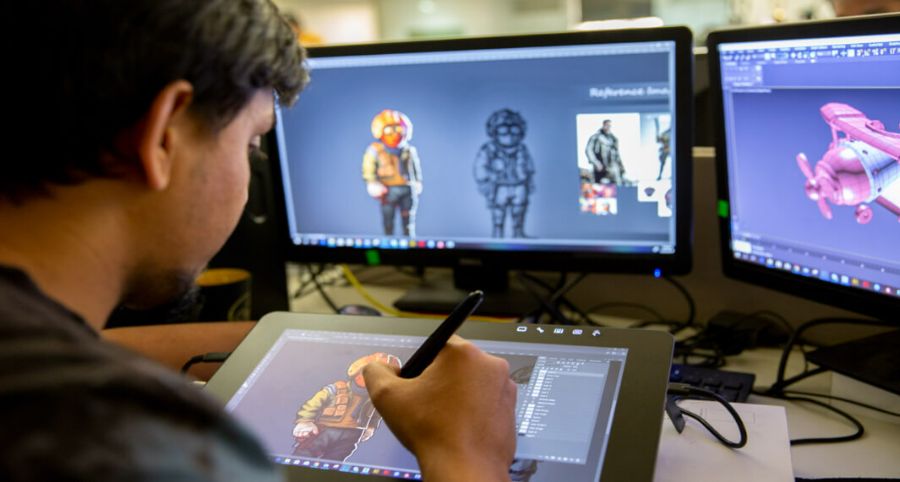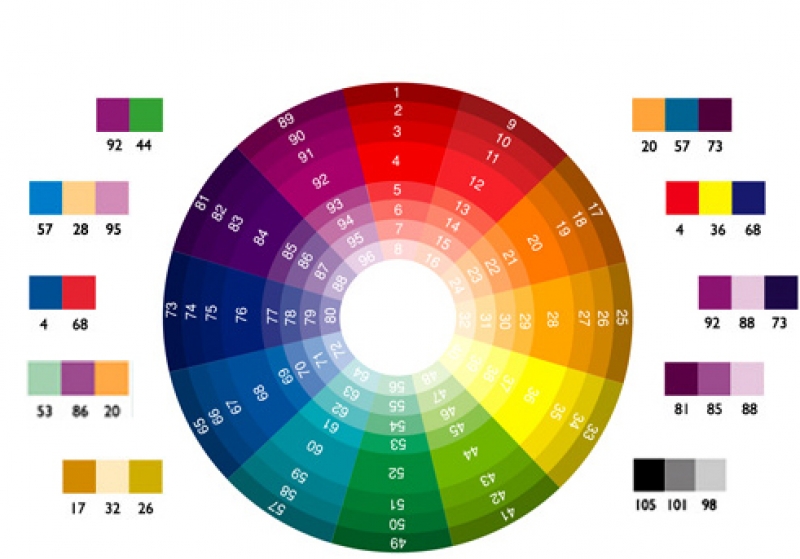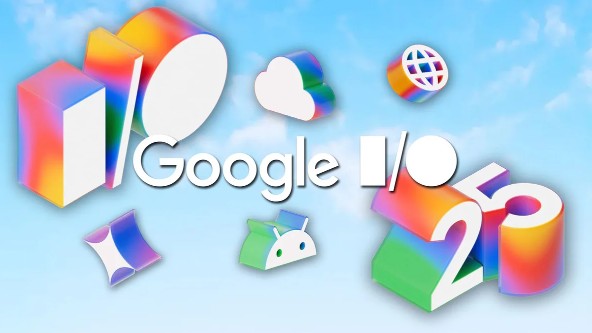Best Selling Products
Concept Art: The Importance and Role of a Concept Artist
Nội dung
- 1. Overview of Concept Art
- 2. Origin and development of Concept Art
- 2.1 The early stages of animation and film industry
- 2.2 Boom in the gaming industry
- 3. The central role of the concept artist in the creative production chain
- 3.1 Visual guide for the project
- 3.2 Bridge between director and production team
- 3.3 Support for testing design feasibility
- 4. Popular Concept Art forms today
- 4.1 Character Concept
- 4.2 Environmental Concept
- 4.3 Prop/Vehicle Concept
- 4.4 Key Visual / Mood Painting
- 5. Skills needed to become a professional concept artist
- 5.1 Basic knowledge of fine arts
- 5.2 Proficient in using digital software
- 5.3 Design Thinking
- 5.4 Communication and teamwork
- 6. Job market and career trends
- 6.1 Growing demand in the creative industry
- 6.2 Trends in remote work and freelancing
- 6.3 Expanding into technology
- 7. Visual thinking and synthesis skills of Concept artists
- 7.1. Visual thinking is the core
- 7.2. Research and integration skills
- 7.3. Visual storytelling skills
- 8. Common concept types and specific roles
- 8.1. Character Concept – Character is the soul of the story
- 8.2. Environment Concept – Space contributes to storytelling
- 8.3. Props & Vehicle Concept – Details make the real thing
- 9. The workflow of a concept artist
- 9.1. Receive the assignment and analyze the creative requirements
- 9.2. Research, develop moodboard and initial ideas
- 9.3. Detailed design and artwork completion
- 10. The Lasting Influence of Concept Art
- 10.1. Is the premise for the whole project to develop
- 10.2. Creating brand image and visual legacy
- 10.3. Contribute to shaping the future of the entertainment industry
- 11. Conclusion
Discover the role of Concept Art in the creative industry and why concept artists are an indispensable cog in modern game, film and animation projects.

Concept Art holds a core position in the modern creative industry, especially in games, movies, animation and advertising. Behind every majestic setting, every impressive character or every fantasy world, there is a clear mark of a concept artist. They are not just sketchers, they are the “visual architects” who create the visual foundation for the entire production process.
1. Overview of Concept Art
Concept Art is a form of visual art used to communicate ideas in visual communication projects. Considered the first step in the visual development process, Concept Art helps producers, directors, and creative teams visually visualize the world, characters, settings, objects, or psychological spaces in a product.
By creating directional sketches, Concept Art acts as a bridge between abstract ideas and concrete visual reality. This is the foundation for other departments such as modeling, animation, VFX or level design to rely on to develop the finished product..jpg)
2. Origin and development of Concept Art
2.1 The early stages of animation and film industry
The concept of Concept Art began in the early 20th century, when major studios such as Disney used illustrations to develop animated characters and backgrounds. The initial drawings were often watercolors and charcoals, sketched by traditional artists to help directors visualize the script.
From the initial simple role, concept artists have increasingly played an important role in building the “world” in the film. The need to build unique environments, special characters and visual logic in fantasy or science fiction film projects has pushed the field of Concept Art to develop strongly.
2.2 Boom in the gaming industry
The explosive growth of the gaming industry since the 1990s has led to a surge in demand for concept artists. Games are no longer just a means of entertainment, but have become products with profound content, deep characters, and meticulously built worlds like movies. Concept Art has therefore become an indispensable starting point for every large and small gaming project.
Along with that, the emergence of supporting software such as Photoshop, Procreate, Clip Studio Paint or Blender also helps concept artists quickly shift from traditional techniques to digital (digital painting), improving work efficiency and flexible customization capabilities.
.jpg)
3. The central role of the concept artist in the creative production chain
3.1 Visual guide for the project
Concept artists are the first to “see” the world the script describes. They draw out scenarios that don’t yet exist, translating descriptions into concrete images – from weapons, spaceships, monsters to post-apocalyptic landscapes. These drawings are the basis for other departments to coordinate production.
Unlike illustrators, who focus on expressing emotion or detail, concept artists prioritize visual logic, aiming to solve technical problems and consistency between elements in a fictional world.
3.2 Bridge between director and production team
A good director can imagine a wild world, but it’s the concept artist who brings it to life. Concepts help the entire team understand the artistic direction and style of the project from the start, thus avoiding “tone mismatches” in post-production.
They also play an important role in pitching or presenting ideas to investors and partners. An excellent concept can help convince partners to invest in the project thanks to its high visuality and inspirational ability.
3.3 Support for testing design feasibility
In addition to creating beautiful visuals, concept artists also take on the role of “testing” the visuals for feasibility. They need to carefully consider lighting, materials, scale relationships, architecture, and technological feasibility – for example, can the character move smoothly, or is it too difficult to model.
In other words, they are the “R&D department” of the image before the product enters the mass production stage.
.jpg)
4. Popular Concept Art forms today
4.1 Character Concept
Focuses on the design of main, supporting, and NPC characters, including faces, body shapes, clothing, expressions, and poses. This type of concept requires an understanding of anatomy, fashion, expression, and character personality.
4.2 Environmental Concept
Involves designing environments – from jungles, ancient cities, to distant planets. Artists need to understand perspective, lighting, architecture, geology, and culture to design environments that fit the story’s setting.
4.3 Prop/Vehicle Concept
Specialized for objects such as weapons, vehicles, technical equipment, household items... This type requires high detail, suitable for the general style of the project, while ensuring practicality when put into the 3D model.
4.4 Key Visual / Mood Painting
While not technically a concept, cinematic, emotional images such as key visuals are also part of the concept artist’s remit. They are an important tool in conveying the overall mood, lighting, atmosphere, and emotional tone of the entire project.
5. Skills needed to become a professional concept artist
5.1 Basic knowledge of fine arts
A solid grasp of fundamental principles such as shape, light, color, and anatomy is a prerequisite. In addition, good hand drawing skills help artists sketch ideas quickly and flexibly during the brainstorming phase.
.jpg)
5.2 Proficient in using digital software
Software such as Photoshop, Blender, ZBrush, Procreate… are indispensable tools. Knowing how to combine 2D and 3D in the concept creation process helps speed up modeling and test lighting and materials more effectively.
5.3 Design Thinking
A character or setting does not exist in isolation but within a logical system. Good concept artists need to understand the historical, social, and design language context of the world they are creating. Systemicity makes the product more consistent and convincing.
5.4 Communication and teamwork
In a studio environment, communication skills are essential. Artists must explain designs to directors, producers, modelers, or animators – not just visually, but in clear, compelling language.
6. Job market and career trends
6.1 Growing demand in the creative industry
The global entertainment industry – including games, movies, TV series, digital advertising – is growing rapidly. With each project, the demand for high-quality images is increasing, driving the need for specialized, experienced concept artists.
6.2 Trends in remote work and freelancing
With the support of technology, many concept artists choose to freelance or work remotely for international studios. With just a strong enough portfolio and good English communication skills, you can completely participate in AAA projects without leaving Vietnam.
6.3 Expanding into technology
In addition to the gaming and film industries, concept artists today also play a role in fields such as VR/AR, Metaverse, AI training data, UX gamification design... The intersection of art and technology opens up multi-dimensional, sustainable and promising development opportunities.
7. Visual thinking and synthesis skills of Concept artists
7.1. Visual thinking is the core
A concept artist is not simply a good painter, but more importantly, they are a “visual thinker”. Visual thinking helps the artist to translate ideas from the script into concrete, highly suggestive forms for the entire design team.
The sensitivity in choosing frames, lighting, perspective, colors as well as the use of shapes contribute to expressing the emotions, nuances and core spirit of the world built.
7.2. Research and integration skills
Unlike creating in a “vacuum”, concept artists need to know how to research, select and synthesize real elements in life, history, architecture and culture to form the foundation for the fictional world.
A futuristic warrior’s armor design might be inspired by samurai armor, incorporating nanotechnology and Asian mythological symbols – all of which must be both visually appealing and logically relevant. A good concept artist is not only good at drawing, but also at researching, observing and deducing.
7.3. Visual storytelling skills
Every design, from characters to environments, needs to have an underlying story. The wear and tear on armor, the rust, the character’s eyes, facial expressions, or stance – they all need to have a reason to exist.
Concept artists use their images to convey the character's background, psychology, personality, and destiny, as well as the history and atmosphere of the world they create. This is what separates a "pretty" design from a "deep" one.
8. Common concept types and specific roles
8.1. Character Concept – Character is the soul of the story
A character is a direct point of connection with the audience. A well-designed character will convey psychology, beliefs, and personal journey through their eyes, clothing, or accompanying weapons.
Concept artists need to draw dozens, even hundreds of versions of a character to find the optimal solution, ensuring that it is iconic, unique, and consistent with the plot. They also have to consider the ability to operate in a 3D environment or when animated in animation or cinema.
8.2. Environment Concept – Space contributes to storytelling
Landscapes, structures, background objects – all are the “stage” where the story takes place. A post-apocalyptic city, an unexplored wilderness planet, or a nostalgic room from the 20s… all need to be clearly conceptualized in terms of lighting, weather, architecture, and cultural context.
The environment concept artist is responsible for establishing atmosphere, spatial depth, and visual focal points to shape the visual experience for the audience or player. This is a crucial step in developing a consistent and believable world.
8.3. Props & Vehicle Concept – Details make the real thing
Objects such as weapons, vehicles, machines, tools, etc. are indispensable in works of science fiction or action. Every little detail can contribute to the building of culture, technology, and even the level of development of the created world.
Props are not just accessories, but also “storytelling materials” through traces of use, materials, or distinctive designs. Concept artists combine art with mechanics, engineering, and industrial design to create living objects.
9. The workflow of a concept artist
9.1. Receive the assignment and analyze the creative requirements
Initially, the artist will work directly with the art director or creative director to understand the project's goals, visual style, historical period (if applicable), target audience, and emotional tone of the product.
Thorough understanding from the beginning helps to guide the design right from the first sketch, avoiding wasting time and resources.
.jpg)
9.2. Research, develop moodboard and initial ideas
The concept artist will study reference images, create a moodboard to suggest color tone, lighting, and overall visual context. This stage also includes quick sketches of ideas (thumbnails), layout testing, and creating a series of preliminary drawings.
Speed and flexibility are important, as creative teams often need dozens of different options before settling on a definitive direction.
9.3. Detailed design and artwork completion
Once the concept is approved, the artist will continue to refine, add materials, lighting, shading, check perspective and physics logic to create detailed drawings that can be fed into production pipelines such as 3D modeling, animation or cinematic effects.
The final concept drawing does not need to be as “perfect” as a traditional painting, but it must be clear in form, function and suggestive of application.
10. The Lasting Influence of Concept Art
10.1. Is the premise for the whole project to develop
Without a concept, the entire production chain – from modeling, lighting, VFX, to animation – would be lost. Concept art helps reduce errors, streamline the process, and ensure that every step is consistent with the original artistic vision.
A project with a good concept will always save production time and significantly reduce post-production editing costs.
10.2. Creating brand image and visual legacy
Classic visual icons – from Darth Vader (Star Wars), Iron Man, to Pokémon – were all born from a first concept. Concept artists help create the visual identity of an entire brand or franchise.
From movies, to games, to comics, a strong concept can become a pop culture icon, lasting decades in the public mind.
10.3. Contribute to shaping the future of the entertainment industry
In the era of AI and VR/AR technology development, concept art is changing dramatically. Artists are no longer just drawing in 2D but also experimenting with real-time 3D space, interaction, and cross-platform expression.
The role of the concept artist in the future will expand to include the metaverse, interactive cinema, non-linear gaming, and many other new areas – where visuals are at the heart of every experience.
11. Conclusion
Concept Art is not just beautiful drawings, but the visual heart of every visual communication project. Concept artists are the ones who breathe life into seemingly impossible ideas, turning them into vivid, emotional and imaginative worlds. In the context of the creative industry constantly expanding its borders, understanding and investing in Concept Art properly not only helps to elevate the product but also creates long-term brand value. Whether you are a large studio or an independent creator, having a “visual architect” on your team is an advantage that cannot be ignored.












































